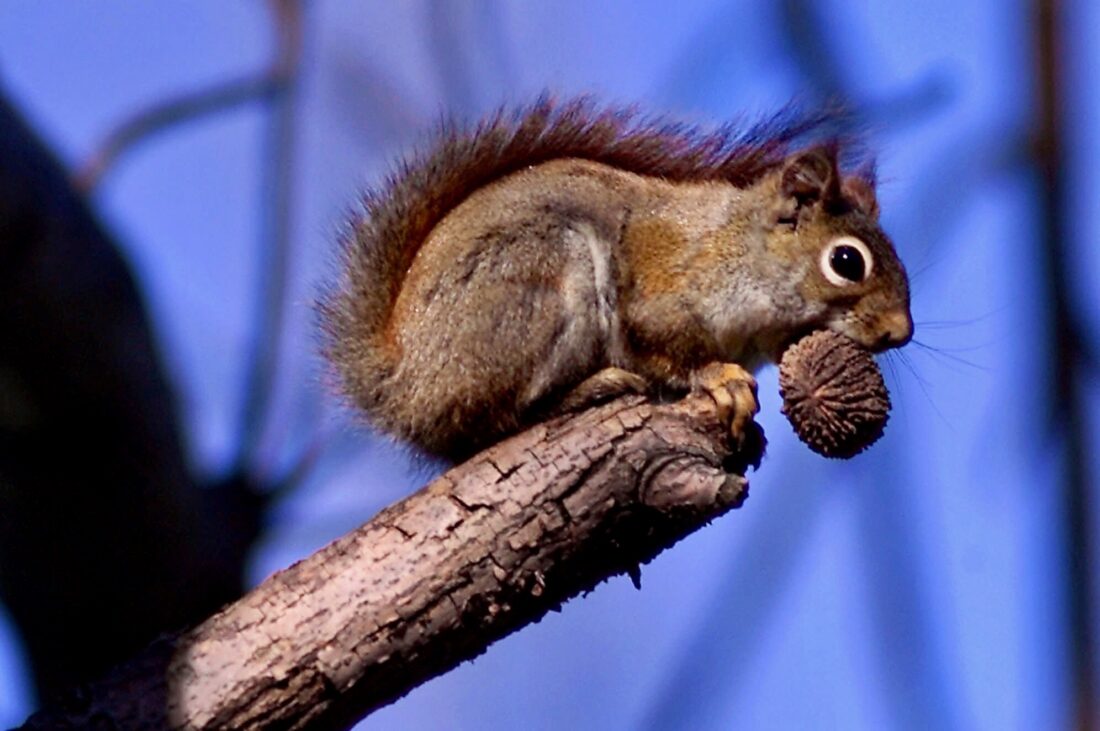The Black Walnut: A versatile and valuable native tree
A versatile and valuable native tree
- A red squirrel sits in a tree with an ample meal of a black walnut in his mouth in Bainbridge, Ohio, Tuesday, April 25, 2000. (AP Photo/Amy Sancetta)

A red squirrel sits in a tree with an ample meal of a black walnut in his mouth in Bainbridge, Ohio, Tuesday, April 25, 2000. (AP Photo/Amy Sancetta)
J.J. Barrett
WVU Extension
Hello Mid-Ohio Valley farmers and gardeners! A chance of frost is in the forecast as the growing season winds its way down. Many gardeners perform a fall cleanup and plant a cover crop such as winter wheat in the garden space.
However, vegetable gardening can be done year-round, so now is the time to get your fall garden started with broccoli, cabbage, carrots, beets, Swiss chard, kale and other cool season veggies. Are you looking for some inspiration? Find a copy of Eliot Coleman’s groundbreaking gardening book “Four Season Harvest.” Coleman harvests vegetables year round from his farm in Maine.
Early summer 2025 provided ample moisture for vegetable, crop and fruit tree production. I have also noticed there is an abundant crop of black walnuts this fall. The Eastern Black Walnut (Juglans nigra) is a tremendously valuable native tree here in West Virginia.
This week marks the 71st annual Black Walnut Festival in Spencer, W.Va. This festival celebrates the black walnut, with a full schedule of parades, live music, carnival rides, contests, the “Nut Sweepstakes” and local vendors.
Black walnuts have provided food for humans and wildlife for centuries, and this beautiful wood is utilized for some of the finest quality furniture. This tree’s dark colored wood is also used for gun stocks, fencing, and making cabinets.
Black walnut has an exceptional and distinctive history. The prized wood was exported from the colonies as early as the 1600’s (these were the 150-foot beauties) and used for all manner of furniture making. In the 1830’s the dark grained wood exploded in popularity due to Victorian style furniture crafting.
Although many of the huge walnut trees were gone, thousands of split rail fences and railroad ties were made with walnut because of its resistance to rot when in contact with the soil. Furthermore, black walnut was used for decades for making gunstocks by the U.S. Government. It is still the favorite wood for building hunting shotguns and rifles.
The black walnut has a huge range of growth over the Eastern United States from Massachusetts to Iowa, southwest through Georgia, the Carolinas, and westward through the Gulf all the way to east Texas. They love rich, well-drained soils and were found in river and creek bottoms when the pioneers settled this area.
Black walnut trees are found in mixed hardwood forests, pastures, and meadows here in West Virginia. Although it prefers fertile soils, it will tolerate dry, poor soils but this will significantly reduce tree growth rate.
A black walnut usually matures in about 150 years. When grown in a forest stand, average mature trees are approximately 70 to 80 feet in height and attain diameters of 2 to 4 feet. In optimal growth areas, this tree may reach up to 150 feet tall and over 8 feet in diameter.
When grown at a low stocking rate or in open fields, black walnut produces a short, wide spreading crown. Black walnut is monoecious, meaning that male and female flowers grow on the same tree and the fruit is a nut enclosed within a yellowish-black casing.
Black walnuts can be planted for both nut and wood production. Over 400 commercial varieties of black walnut are available for farmers and homeowners to purchase. Most varieties have been selected for their nut quality, but there are varieties planted for timber production.
Seedlings and saplings are notorious for having a single, very deep taproot that makes transplanting difficult. Therefore, many varieties are typically propagated from grafts. Black walnut is virtually a disease and pest free tree but is susceptible to anthracnose.
Black walnut trees are unique because of their production of the chemical juglone, which is concentrated in the nut hulls, buds and roots. Juglone is an alleopathic toxin which prevents the growth of many other plants within the tree’s rooting zone.
Many vegetables are sensitive to juglone, so do not locate gardens or flower beds near black walnut trees. In a woodland setting, very few plants grow under the canopy of black walnut. Even after removal, decaying black walnut tree roots continue to release this toxin.
Black walnut is an important and valuable tree for nuts and fine lumber. However, this nut tree does have some drawbacks, besides the production of juglone if located near the home landscape. If summer moisture is lacking, this tree will start to lose leaves, in spite of its deep taproot system.
The tree does create clean-up chores and mowing hazards with a continuous dropping of leaflets, dead twigs, stain-laden whole fruits, and debris from squirrel feeding from mid-summer until late autumn. The outside husk contains compounds that may stain cars, sidewalks, and porches in addition to your hands.
Black walnuts can be part of a healthy diet and have many health benefits. They have a significant higher omega-3 fatty acid content and more protein than their cousin, the English walnut. The omega-3’s make these nuts very heart healthy.
Furthermore, black walnuts have strong antiviral, antiparasitic and antifungal properties. It can be a useful natural tool for improving digestion by soothing upset stomachs and the juice from unripe black walnut hulls may be used for fungal skin issues.
The prime time to gather walnuts is late September to early October. Most walnuts are still hand harvested from trees growing in native stands throughout the Midwest and Northeast. An amazing 10,000 metric tons of black walnuts are harvested annually here in the U.S.
The Hammons Black Walnut Company in Missouri purchases millions of pounds of nuts from approximately 215 buying locations across the United States. These stations serve as collection points where the nuts are hulled and bagged for shipment.
It does take some effort to enjoy the bold and rich taste of black walnuts and you may need some gloves. Harvest black walnuts as soon as the outer husk softens, but is still green. If your finger leaves a depression in the husk, they are ready. You can wait till nuts start to drop before gathering or shake from tree limbs.
The nutshell is covered by a thick husk that contains a dark, staining, strong-smelling juice which is first yellow brown but quickly becomes a deep black-green color when exposed to the air. Walnuts should be hulled immediately after harvest.
There are many methods of dehulling walnuts including using an old fashioned corn sheller, running over them with a vehicle, stomping them with your feet and using water and gravel in a portable cement mixer. If you are working with dry nuts, the husk can be removed by applying pressure to the ends of the nut with a hammer (use safety glasses!)
Once you have the husk off, wash the unshelled nuts to remove excess juice and debris. Any unfilled nuts will float and should be thrown out. Walnuts must be dried and cured for storage. Spread out freshly husked and washed walnuts (not too deep) in a well-ventilated area out for about two weeks for drying.
Unlike its easy-to-split-open cousin the English walnut (it has a naturally thinner shell), this is a tough nut to crack. You can’t hit them so that they fall into halves as you can with hickory nuts. The black walnut shell is extremely hard and can only be breached with a hammer.
Ground black walnut shells (a by-product of the industry to make it profitable) are used for many industrial applications including metal cleaning and polishing, additives to paint, explosives, and make-up
The unique black walnut flavor can be enjoyed by eating raw walnuts or using them in recipes. They can be substituted for other nuts or used in traditional recipes such as walnut sheet cake, cookies, black walnut ice cream, added to fudge, salad dressings, muffins and breads.
More information on growing, harvesting and cooking with black walnuts can be found at the Hammons Black Walnut website black-walnuts.com.
Pay attention about storage after you have gone through all the work of shelling these nuts. The oil content of the walnuts may cause them to turn rancid, so throw them in a zip lock bag and store them in the freezer.
If you want to gather black walnuts this fall, there is a collection station for Hammons Walnuts at Integration Acres near Athens, Ohio. They will run the walnuts through a hulling machine and pay you by weight. Contact the office for more details. Buy local and enjoy!
Contact me at the Wood County WVU Extension Office 304-424-1960 or e-mail me at jj.barrett@mail.wvu.edu with questions. Good Luck and until next time, Happy Gardening!



